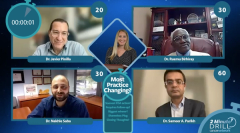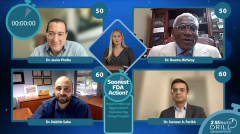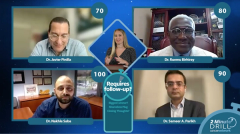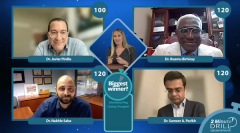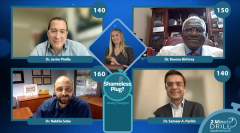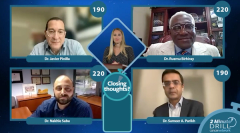
2-Minute Drill: Trials Needing Follow-Up From the 2023 ASCO Annual Meeting
Thought leaders from various institutions offered their take on the trial the trial they think may need the most follow-up as a next step following the 2023 ASCO Annual Meeting.
Episodes in this series

Following the 2023 ASCO Annual Meeting, Ruemu E. Birhiray, MD, Hematology Oncology of Indiana; Sameer A. Parikh, MBBS, Mayo Clinic; Javier Pinilla, MD, PhD, Moffitt Cancer Center; and Nakhle Saba, MD, Tulane University School of Medicine, discuss the trial they think may need the most follow-up as a next step following the meeting.
The participants had 1 minute each to give their response.
Kahl: So let's keep it going. Again, 1 minute each, what trial maybe requires the most follow-up as a next step out of ASCO. Dr. Pinilla, we'll start with you.
Pinilla: I think the ALLIANCE trial still needs to be followed. I think, obviously, we have been discussing that the triplets are not really showing any benefit over the doublets, but I don't think that was the right doublet to use. We usually see something that we are really substituting with venetoclax [Venclexta] combination. But I mean, what's interesting, the early read out I mean, we discussed the obvious toxicities there, infection. Are those all patients that are not really a very good fit for too many drug combinations. But definitely, I think we need to really follow over time how these data evolve though, in my opinion, for what I see my practice. I would like to see longer follow-up in all of these trials.
Kahl: Good point, 30 points. Dr. Saba?
Saba: The SWOG 1826 [trial in Hodgkin lymphoma] for sure. But also the CAPTIVATE fixed duration cohorts. So in this phase 2 trial, nearly 160 [treatment-naïve] patients [with] CLL retrieved a single agent of ibrutinib [Imbruvica] for 3 months lead in, then followed by a 12-month addition on top of ibrutinib of venetoclax for a total of 15 months. Now the 4-year data that was presented this ASCO and continued to show durable responses with a 4-year PFS nearing 80%; however, the 4-year PFS rates were numerically lower in unmutated IGHV at 73% and TP53 alteration at 63%. So long-term follow up here is needed for the fixed duration and also for the MRD cohort to see whether those high-risk patients with CLL will continue to have a suboptimal outcome following recent strategy and whether continuous clonal suppression, with a BTKIs, for example, is needed.
Kahl: Absolutely. We're going to go 20 points. Dr. Birhiray?
Birhiray: Yes, I'm going to switch to multiple myeloma. So as you know, in multiple myeloma, there is 1 bispecific antibody that's currently approved, which is teclistamab [Tecvayli]. But teclistamab was combined with talquetamab, which is another bispecific, which is yet to be approved, that targets different target. And the combination of 2 bispecifics was found to be safe. And not only was it safe, almost 95% of those patients responded in a disease where patients were pentarefractory, were relatively resistant to chemotherapy, and had received multiple prior lines of therapy without any new safety signals. So I think that if additional follow-up indicates that that steroid-free regimen results in those improvements and outcomes and support it, that could be a game-changer in the treatment of multiple myeloma.
Kahl: Absolutely, we're going to go 40 points there. Dr. Parikh, close this out.
Parikh: So, this is a trick question. You know, I think every single trial–we were joking about this before we started filming–needs longer follow-up, right? I mean, I think, longer follow-up clarifies so many things. So I would like to see longer follow-up for practically every study that is out there, because things change over time. And I think we need to do that. But I agree with Dr. Saba, I think the SWOG study is the most interesting of all the hematologic malignancy presentations during the overall survival took about 6 years for the nivolumab [Opdivo]-AVD vs ABVD study to be presented last year. I don't know how long this study might take comparing the nivo-AVD with ABVD, vs ipilimumab[Yerboy]-nivo-AVD versus rituximab [Rituxan]-AVD. So we'll see how long that takes for us to show our overall survival benefit.
Kahl: Yeah, absolutely. It's a great point, 30 points.
Transcription edited for clarity.
Newsletter
Stay up to date on recent advances in the multidisciplinary approach to cancer.


